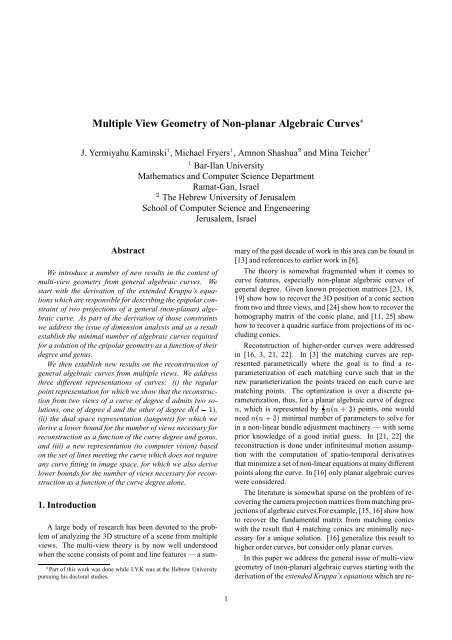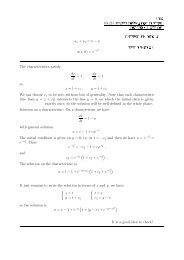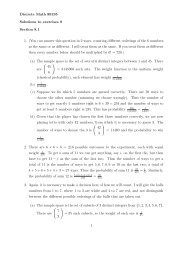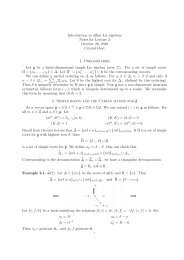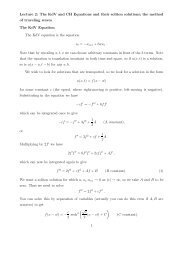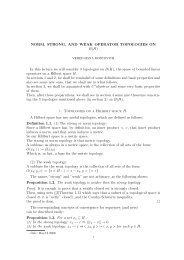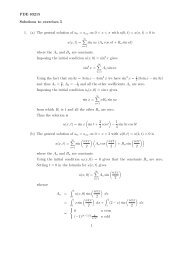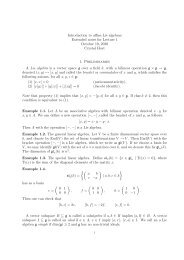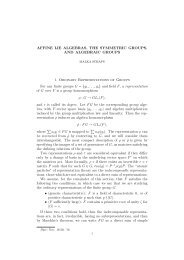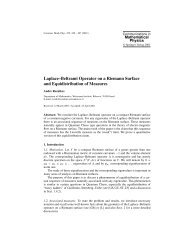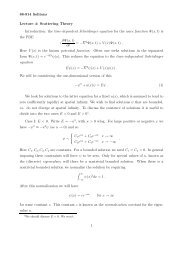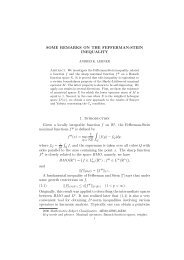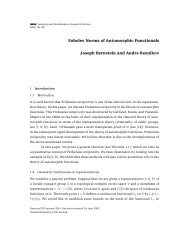Multiple View Geometry of Non-planar Algebraic Curves
Multiple View Geometry of Non-planar Algebraic Curves
Multiple View Geometry of Non-planar Algebraic Curves
Create successful ePaper yourself
Turn your PDF publications into a flip-book with our unique Google optimized e-Paper software.
¢¡<strong>Multiple</strong> <strong>View</strong> <strong>Geometry</strong> <strong>of</strong> <strong>Non</strong>-<strong>planar</strong> <strong>Algebraic</strong> <strong>Curves</strong>J. Yermiyahu Kaminski ¡ , Michael Fryers ¡ , Amnon Shashua ¢ and Mina Teicher ¡Bar-Ilan UniversityMathematics and Computer Science DepartmentRamat-Gan, IsraelThe Hebrew University <strong>of</strong> JerusalemSchool <strong>of</strong> Computer Science and EngeneeringJerusalem, IsraelAbstractWe introduce a number <strong>of</strong> new results in the context <strong>of</strong>multi-view geometry from general algebraic curves. Westart with the derivation <strong>of</strong> the extended Kruppa’s equationswhich are responsible for describing the epipolar constraint<strong>of</strong> two projections <strong>of</strong> a general (non-<strong>planar</strong>) algebraiccurve. As part <strong>of</strong> the derivation <strong>of</strong> those constraintswe address the issue <strong>of</strong> dimension analysis and as a resultestablish the minimal number <strong>of</strong> algebraic curves requiredfor a solution <strong>of</strong> the epipolar geometry as a function <strong>of</strong> theirdegree and genus.We then establish new results on the reconstruction <strong>of</strong>general algebraic curves from multiple views. We addressthree different representations <strong>of</strong> curves: (i) the regularpoint representation for which we show that the reconstructionfrom two views <strong>of</strong> a curve <strong>of</strong> degree admits two solutions,one <strong>of</strong> £degree and the other <strong>of</strong> degree ,(ii) the dual space representation (tangents) for which wederive a lower bound for the number <strong>of</strong> views necessary for£ £¥¤¦£¨§©reconstruction as a function <strong>of</strong> the curve degree and genus,and (iii) a new representation (to computer vision) basedon the set <strong>of</strong> lines meeting the curve which does not requireany curve fitting in image space, for which we also derivelower bounds for the number <strong>of</strong> views necessary for reconstructionas a function <strong>of</strong> the curve degree alone.1. IntroductionA large body <strong>of</strong> research has been devoted to the problem<strong>of</strong> analyzing the 3D structure <strong>of</strong> a scene from multipleviews. The multi-view theory is by now well understoodwhen the scene consists <strong>of</strong> point and line features — a sum-Part <strong>of</strong> this work was done while J.Y.K was at the Hebrew Universitypursuing his doctoral studies.mary <strong>of</strong> the past decade <strong>of</strong> work in this area can be found in[13] and references to earlier work in [6].The theory is somewhat fragmented when it comes tocurve features, especially non-<strong>planar</strong> algebraic curves <strong>of</strong>general degree. Given known projection matrices [23, 18,19] show how to recover the 3D position <strong>of</strong> a conic sectionfrom two and three views, and [24] show how to recover thehomography matrix <strong>of</strong> the conic plane, and [11, 25] showhow to recover a quadric surface from projections <strong>of</strong> its occludingconics.Reconstruction <strong>of</strong> higher-order curves were addressedin [16, 3, 21, 22]. In [3] the matching curves are representedparametrically where the goal is to find a reparameterization<strong>of</strong> each matching curve such that in thenew parameterization the points traced on each curve arematching points. The optimization is over a discrete parameterization,thus, for a <strong>planar</strong> algebraic curve <strong>of</strong> degree, which is ¤ represented by points, one¤would need minimal number <strong>of</strong> parameters to solve forin a non-linear bundle adjustment machinery — with someprior knowledge <strong>of</strong> a good initial guess. In [21, 22] thereconstruction is done under infinitesimal motion assumptionwith the computation <strong>of</strong> spatio-temporal derivativesthat minimize a set <strong>of</strong> non-linear equations at many differentpoints along the curve. In [16] only <strong>planar</strong> algebraic curveswere considered.The literature is somewhat sparse on the problem <strong>of</strong> recoveringthe camera projection matrices from matching projections<strong>of</strong> algebraic curves.For example, [15, 16] show howto recover the fundamental matrix from matching conicswith the result that 4 matching conics are minimally necessaryfor a unique solution. [16] generalize this result tohigher order curves, but consider only <strong>planar</strong> curves.In this paper we address the general issue <strong>of</strong> multi-viewgeometry <strong>of</strong> (non-<strong>planar</strong>) algebraic curves starting with thederivation <strong>of</strong> the extended Kruppa’s equations which are re-1
,%¤#¤%sponsible for describing the epipolar constraint <strong>of</strong> two projections<strong>of</strong> a general (non-<strong>planar</strong>) algebraic curve. As part<strong>of</strong> the derivation <strong>of</strong> those constraints we address the issue<strong>of</strong> dimension analysis and as a result establish the minimalnumber <strong>of</strong> algebraic curves required for a solution <strong>of</strong> theepipolar geometry as a function <strong>of</strong> their degree and genus.On the reconstruction front, we address three differentrepresentations <strong>of</strong> curves: (i) the regular point representationfor which we show that the reconstruction from twoviews <strong>of</strong> a curve <strong>of</strong> degree admits two solutions, one <strong>of</strong>£degree and the other <strong>of</strong> degree , (ii) dual spacerepresentation (image measurements are tangent lines) forwhich we derive a formula for the minimal number <strong>of</strong> views££¥¤¦£¨§©necessary for reconstruction as a function <strong>of</strong> the curve degreeand genus, and (iii) a new representation (with regardto computer vision) based on the set <strong>of</strong> lines meeting thecurve which does not require any curve fitting in imagespace, for which we also derive formulas for the minimalnumber <strong>of</strong> views necessary for reconstruction as a function<strong>of</strong> curve degree alone.2. Recovering the epipolar geometry fromcurve correspondencesAn algebraic relation between matching algebraic curvescan be regarded as an extension <strong>of</strong> Kruppa’s equations. Intheir original form, these equations have been introduced tocompute the camera-intrinsic parameters from the projection<strong>of</strong> the absolute conic onto the two image planes [20].However it is obvious that they still hold if one replacesthe absolute conic by any conic, or even any <strong>planar</strong> algebraiccurve, which plane does not meet any <strong>of</strong> the cameracenters [16]. We will show next that a generalization forarbitrary algebraic (non-<strong>planar</strong>) curves is possible and is astep toward the recovery <strong>of</strong> epipolar geometry from matchingcurves.Let be a smooth irreducible (non-<strong>planar</strong>) curve ¡£¢ in ,whose degree is . Let ¨ be the camera matrix, © thecamera center, £¥¤§¦ the retinal plane and the image curve.Here we mention a short list <strong>of</strong> well known facts (see [14,12, 5, 4]):1. We recall that a singularity <strong>of</strong> a <strong>planar</strong> curve is simplya point where the curve admits more than one tangent.The curve will always contain singularities.2. For a generic position <strong>of</strong> the camera center, the onlysingularities <strong>of</strong> will be nodes, that is points with twodistinct tangents.3. We define the class <strong>of</strong> the <strong>planar</strong> curve to be the degree<strong>of</strong> its dual curve. Let be the class <strong>of</strong> . It is a wellknownfact that is constant for a generic position <strong>of</strong>the camera center.4. For a generic position <strong>of</strong> © , will have same degreeand genus asNote it is possible to give a formula for as a function<strong>of</strong> the degree and the genus <strong>of</strong> . According to Plückerformula, we have:££¥¤¦£ § © §¦ ¤§ © ¤¦£ §¦ ¤¦£¦nodes nodes §¤where nodes denotes the number <strong>of</strong> nodes <strong>of</strong> (note thatthis includes complex nodes). Hence the genus, the degreeand the class are related by:§¦2.1. Extended Kruppa’s equations¦ £ ¦We are ready now to investigate the recovery <strong>of</strong>©¦the,be the fundamentalepipolar geometry from matching curves. ¨ Let ,be the camera matrices. Let andmatrix and the first epipole, "! . We will need to considerthe two following #$&%(') +* % mappings:and. Both are defined on the first image plane;$-%('./%associates a point to its epipolar line in the first image,#while sends it to its epipolar line in the second image.Let , and be the image curves (projections <strong>of</strong> ontothe image planes). 0Let 0 and be the polynomials thatrepresent respectively and . 21 Let 21 and denote thedual curves, whose polynomials are 3respectively 3 and .Roughly speaking, the extended Kruppa’s equations statethat the sets <strong>of</strong> epipolar lines tangent to the curve in each imageare projectively related. A similar observation has beenmade in [2] for epipolar lines tangent to apparent contours<strong>of</strong> objects, but it was used within an optimization scheme.Here we are looking for closed-form solutions, where noinitial knowledge <strong>of</strong> the answer is required. In order to developsuch a closed-form solution for the computation <strong>of</strong> theepipolar geometry, we need a more quantitative approach,which is given by the following theorem:Theorem 1 Extended Kruppa’s equationsFor a generic position <strong>of</strong> the camera centers with respectto the curve in space, there exists a non-zero scalar 4 , suchthat for all points % in the first image, the following equalityholds:3 ¤5, ¤ "463Observe that if is a conic 7 and and 7 the matricesthat respectively represent and , the extendedKruppa’s equations reduce to the classical Kruppa’s equa-9;:< 9 = :721 8 tions, that 721 is: 721 8 , whereare the adjoint matrices <strong>of</strong> 7and 7 . (1)and 721Pro<strong>of</strong>: Let ? be the set <strong>of</strong> epipolar lines tangent to thecurve in image . We start by proving the following lemma.2
¤¤¤¦#¤¤¡¤¤§¦©©:¤¤¤Lemma 1 The two ? sets and ? are projectively equivalent.Furthermore for each corresponding pair <strong>of</strong>epipolarlines, ¡£ ? ¦? , the multiplicity <strong>of</strong> and as points§£<strong>of</strong> the dual curves ¤¡ ¢ and ¥¤ 1 are the same. 1 Pro<strong>of</strong>: Consider the three following pencils: = ¤¡© ¡ , the pencils <strong>of</strong> planes containing the base-¨ 1.line, generated by the camera centers,¨ =2. ¡ , the pencil <strong>of</strong> epipolar lines through thefirst epipole,¨ 3.second epipole. = ¡ , the pencil <strong>of</strong> epipolar lines through theThus ?¨ we have . Moreover if is the set <strong>of</strong>¤¡©planein tangent to the curve in space, there exist a one-toonemapping from ? to each . This mapping also leaves¨the multiplicities unchanged. This completes the lemma.This lemma implies that both side <strong>of</strong> the equation 1 definethe same algebraic set, that the union <strong>of</strong> epipolar linesthrough tangent to . 3Since 3 and , in the genericcase, have same degree (as stated in 2), each side <strong>of</strong> equation1 can be factorized into linear factors , satisfying thefollowing:As a result, in a generic situation every solution <strong>of</strong>'&$%+ 0¡$% ¦ ¦ '&¡#" : 2. 1.is admissible. Let be the sub-variety <strong>of</strong>defined by the equations togetherwith and , where is thesecond epipole. We have the two following results, whichare proven in [1]. The first <strong>of</strong> them gives a lower bound <strong>of</strong>the dimension 0 <strong>of</strong> as a function <strong>of</strong> , whereas the secondgives a sufficient condition for 0 a to be a finite set.Proposition 2 If 0 is non-empty, the dimension <strong>of</strong> 0 is at3 least .Proposition 3 For a generic position <strong>of</strong> the camera centers,the 0 variety will be discrete if, for any pointis not contained in any quadric surface. ¥¤0 , the union <strong>of</strong> © and the points 465Observe that these two results are consistent, since therealways exist a quadric surface containing a given line andsix given points. However in general there is no quadriccontaining a given line and seven given points. Thereforewe can conclude with the following theorem.Theorem 2 For a generic position <strong>of</strong> the camera centers,the extended Kruppa’s equations define the epipolar geometryup to a finite-fold ambiguity if and only 3 if . 3¤ ¢ 3 ¤5, ¤ ¢ ¤¡¤¡4 ¢ ¢ ( where . By the previous lemma, wemust also ! have for .By eliminating the 4 scalar from the extended Kruppa’sequations (1) we obtain a set <strong>of</strong> bi-homogeneous equationsin and . Hence they define a variety ¡ ¦ ¡#" in . Thisgives rise to an important question. How many <strong>of</strong> thoseequations are algebraically independent, or in other wordswhat is the dimension <strong>of</strong> the set <strong>of</strong> solutions? This is theissue <strong>of</strong> the next section.Since different curves in generic position give rise to independentequations, this result means that the sum <strong>of</strong> theclasses <strong>of</strong> the image curves must be at 3 least 0 for to be afinite set. Observe that this result is consistent with the factthat four ( conics for each conic) in general positionare sufficient to compute the fundamental matrix, as shownin [15, 16]. Now we proceed to translate the result in terms<strong>of</strong> the geometric properties <strong>of</strong> directly using the degreeand the genus <strong>of</strong> , related to by the following¦ £relation:¦ § ¦. Here are some examples for sets <strong>of</strong> curvesthat allow the recovery <strong>of</strong> the fundamental matrix:1. Four conics ( ¦ ! ) in general position.2. Two rational cubics ( £ ! ) in general position.£2.2. Dimension <strong>of</strong> the set <strong>of</strong> solutions$%+'&Let be the set <strong>of</strong> bi-homogeneous equations on and , extracted from the extended Kruppa’sequations (1). Our first concern is to determine whether allsolutions <strong>of</strong> equation (1) are admissible, that is whether theysatisfy the usual ! constraint . Indeed the followingstatement can be proven [1]:Proposition 1 As long as there are at least 2 distinctlines through tangent to , equation (1) implies that(')+*-, and /. .3. A rational cubic and two conics in general position.4. Two elliptic cubics ( £(see also [16]).5. A general rational quartic ( 87£ 7 ! ), and a generalelliptic quartic ( £3. 3D Reconstruction).) in general positionWe turn our attention to the problem <strong>of</strong> reconstructing analgebraic curve from two or more views, given known cameramatrices (epipolar geometries are known). The basic3
¤&9¨¢:¤¤¤¢¢idea is to intersect together the cones defined by the cameracenters and the image curves. However this intersection canbe computed in three different spaces, giving rise to differentalgorithms and applications. Given the representation inone <strong>of</strong> those spaces, it is possible to compute the two otherrepresentations [1].We shall mention that in [10] a scheme is proposed to reconstructan algebraic curve from a single view by blowingupthe projection. This approach results in a spatial curvedefined up to an unknown projective transformation. In factthe only computation this reconstruction allows is the recovery<strong>of</strong> the projective properties <strong>of</strong> the curve. Moreover thisreconstruction is valid for irreducible curves only. Howeverreconstructing from two projections not only gives the projectiveproperties <strong>of</strong> the curve, but also the relative depth <strong>of</strong>it with respect to others objects in the scene and furthermorethe relative position between irreducible components.3.1. Reconstruction in Point SpaceLet the camera projection 8 ¢¡'.matrices 8 £¤¡ 9be and ,§¦¥ §©¨ §©¨ ¨ where , see [17]. Hence the two cones definedby the image curves and the camera centers are given£¤ 9 by: ¤ 0 ¤8 £¤¡ 9 and . Thereconstruction is defined as the curve whose equations are ! and "08 ¢¡'. ! . The irreducible components <strong>of</strong> the intersection(the separate curves) have the following degrees:Theorem 3 For a generic position <strong>of</strong> the camera centers,that is when no epipolar plane is tangent twice to the curve, the curve defined $¢ ! !by has two irreduciblecomponents. One has degree and is the actualsolution <strong>of</strong> the reconstruction. The other one has degree£ § © £¥¤¦£.We skip the pro<strong>of</strong> because <strong>of</strong> its technical content. Thereader could find it in [1]. This result provides an algorithmto find the right solution for the reconstruction in a genericconfiguration, except in the case <strong>of</strong> conics, where the twocomponents <strong>of</strong> the reconstruction are both admissible.3.2. Reconstruction in the Dual Space1 Let be the dual variety <strong>of</strong> , that is, the set <strong>of</strong> planestangent to . Since is supposed not to be a line, the dualvariety 1 must be a hypersurface <strong>of</strong> the dual space [12].Hence let be a minimal degree polynomial that represents1 . Our first concern is to determine the degree <strong>of</strong> .Proposition 4 The degree <strong>of</strong> is , that is, the commondegree <strong>of</strong> the dual image curves.Pro<strong>of</strong>: Since 1 is a hypersurface <strong>of</strong> ¡¢ 1 , its degree is thenumber <strong>of</strong> points where a generic line in ¡£¢ 1 meets 1 .By duality it is the number <strong>of</strong> planes in a generic pencilthat are tangent to . Hence it is the degree <strong>of</strong> the dualimage curve. Another way to express the same fact is theobservation that the dual image curve is the intersection <strong>of</strong>1 with a generic plane in ¡ ¢ 1 . Note that this provides anew pro<strong>of</strong> that the degree <strong>of</strong> the dual image curve is constantfor a generic position <strong>of</strong> the camera center.For the reconstruction ¦ <strong>of</strong> from multiple view, we willneed to consider the mapping from a line <strong>of</strong> the imageplane to the plane that it defines with the camera center. Let$ ' denote this mapping [7]. There exists a link involving , and 3 , the polynomial <strong>of</strong> the dual imagecurve: ¤ ¤¡ ¤¡ ! . Since these twopolynomials have the same degree (because is linear) and ! whenever 33 is irreducible, there exist a scalar 4 such thatfor all lines ¤ ¡linear equations on is¤ ¤¡ "463¤¡ §©. Since the number <strong>of</strong> coefficients in, we can state the following result:1 . Eliminating 4 , we getProposition 5 The reconstruction in the dual space can bedone linearly using at ¤ ¨ least views.for few ex-The lower bounds on the number <strong>of</strong> viewsamples are given below:¤ ¦¤ 7 7 7¤ ¤¡ ! § © 1. for a conic locus, ,2. for a rational cubic, ,3. for an elliptic cubic, ,4. for a rational quartic, ,5. for a elliptic quartic, .Moreover it is worth noting that the fitting <strong>of</strong> the dualimage curve is not necessary. It is sufficient to extracttangents to the image curves at distinct points. Each tangentcontributes to one linear equation on : .However one cannot obtain more thanlinearly independent equations per view.3.3. Reconstruction in ¤ © As a third representation <strong>of</strong> the curve , we considerthe set <strong>of</strong> lines meeting . This defines completely thecurve , as shown in [12]. As we shall see, we will paythe price <strong>of</strong> requiring extra views for reconstruction but willgain from the fact that we can use the image points directlywithout the need to perform curve fitting.A line can either be represented by a pair <strong>of</strong> planes ¤ ¤¡ ¢©¦ ¡ ¢© that contain it or by its Plücker coordinatesin the Grassmannian © ¤. For the purpose <strong>of</strong>4
¤©¤%¤¤©¤%¤©¤¤¤%¤¡¤¤%¦¡¤£¤%!¦¡¤¦¡¨!!!¨!©!!!!computation with curves, we found that the representationby Plücker coordinates is more convenient.Hence the curve <strong>of</strong> degree can be represented by ahomogeneous polynomial , called in that context the Chowpolynomial <strong>of</strong> , <strong>of</strong> £ degree , that defines a hypersurface£ ¤ © in . Note that is not uniquely defined. Two suchpolynomials must differ by a multiple <strong>of</strong> the quadratic¤equationdefining as a ¡¢¡ sub-variety <strong>of</strong> . However pick-© ing one representative <strong>of</strong> this equivalence class is sufficientto reconstruct entirely without any ambiguity the curve[12]. The number <strong>of</strong> coefficients £¥¤ in is . Howeversince it is defined modulo the quadratic¤ ©equation definingindependentlinear conditions on its coefficients to determine one, it is sufficient to provide £ ¤¤¨§ -£¤¨§instance <strong>of</strong> .0 Let be the polynomial defining the image curve, .© $ %' ¨ % ¨ ¦ ¨ 00Consider the mapping that associates to an image point itsoptical ray: , where is a matrix, whichentries are polynomials functions <strong>of</strong> [7]. Hence the polynomialvanishes whenever does. Since theyhave same degree and is irreducible, there exists a scalar, we have:1110.5z109.59–1–0.5y00.500.2x 0.40.60.81 1Figure 1. A spatial quarticFigure 2. An electric thread.The curve is smooth and irreducible, and has 7 degreeand genus . We define two camera matrices:©4 such as for every point %©§ © ¦ § ©This yields linear equations on .£ ¤Hence a similar statement to that in Proposition 5 can bemade:Proposition 6 The ¨ reconstructioninlinearly using at least¤ ¡ ¤¤ "© ¤can be doneviews.For some examples, below are the minimal number <strong>of</strong>¤viewsfor a linear reconstruction <strong>of</strong> the © curve in :1. for 7 a conic locus, ,2. ¤ for a cubic, ,¤3. for a quartic, .As in the case <strong>of</strong> reconstruction in the dual space, itis not necessary 0 to explicitly compute . It is enough topick points on the image curve. Each point yieldsalinear! equation on :. However for each£view, onecannot ¢extract more than independent linearequations.4. ExperimentsWe start with a synthetic experiment followed later by areal image one. Consider the curve , drawn in figure 1,defined by the following equations: ¢ ¤ ¤ ¢ § ! !! !§ ©§ ¦ ©© § ! !! !The reconstruction <strong>of</strong> the curve from the two projectionshas been made in the point space, using FGb 1 , a powerfuls<strong>of</strong>tware tool for Gröbner basis computation [8, 9]. Asexpected there are two irreducible components. One has degreeand is the original curve, while the second has 7 degree© ¦.For the next experiment, we consider seven images <strong>of</strong> anelectric wire — one <strong>of</strong> the views is shown in figure 2. Ineach image, we perform segmentation and thinning <strong>of</strong> theimage curve. Hence for each <strong>of</strong> the images, we extracted aset <strong>of</strong> points lying on the thread. No fitting is performed inthe image space. For each image, the camera matrix is calculatedusing the calibration pattern. Then we proceeded tocompute the Chow polynomial <strong>of</strong> the curve in space. Thecurve has degree . Once is computed, a reprojectionis easily performed, as shown in figure 3.5. ConclusionIn this paper we have focused on general (non-<strong>planar</strong>) algebraiccurves as the building blocks from which the camerageometries are to be recovered and as the scene buildingblocks for the purpose <strong>of</strong> reconstruction from multipleviews. The new results derived in this paper include:1 Logiciel conçu et réalisé au laboratoire LIP6 de l’université Pierre etMarie CURIE.§ ©§ © © 460 §¤¡ § ©5
Figure 3. Reprojection on a new image.1. Extended Kruppa’s equations for the recovery <strong>of</strong>epipolar geometry from two projections <strong>of</strong> algebraiccurves.2. Dimension analysis for the minimal number <strong>of</strong> algebraiccurves required for a solution <strong>of</strong> the epipolar geometry.3. Reconstruction from two views <strong>of</strong> a curve <strong>of</strong> degree £is a curve which contains two irreducible componentsone <strong>of</strong> degree £ and the other <strong>of</strong> degree £¥¤¦£ § © — aresult that leads to a unique reconstruction <strong>of</strong> the originalcurve.4. Formula for the minimal number <strong>of</strong> views required forthe reconstruction <strong>of</strong> the dual curve.5. Formula for the minimal number <strong>of</strong> views required¤forthe reconstruction <strong>of</strong> the © curve representation .AcknowledgmentWe express our gratitude to Jean-Charles Faugere for giving usaccess to his powerful system FGb. This research is partially supportedby the Emmy Noether Research Institute for Mathematicsand the Minerva Foundation <strong>of</strong> Germany and the excellency center(Group Theoretic Method In The Study Of <strong>Algebraic</strong> Varieties) <strong>of</strong>the Israeli Academy <strong>of</strong> Science.References[1] J.Y.Kaminski <strong>Multiple</strong>-view <strong>Geometry</strong> <strong>of</strong> <strong>Algebraic</strong><strong>Curves</strong>. Phd dissertation, submitted to Hebrew University <strong>of</strong>Jerusalem, May. 2001.[2] K. Astrom and F. Kahl. Motion Estimation in Image SequencesUsing the Deformation <strong>of</strong> Apparent Contours. InIEEE Transactions on Pattern Analysis and Machine Intelligence,21(2), February 1999.[3] R. Berthilson, K. Astrom and A. Heyden. Reconstruction <strong>of</strong>curves in ¢¡ , using Factorization and Bundle Adjustment. InIEEE Transactions on Pattern Analysis and Machine Intelligence,21(2), February 1999.[4] D. Eisenbud. Commutative Algebra with a view toward algebraicgeometry. Springer-Verlag, 1995.[5] D. Eisenbud and J. Harris. The <strong>Geometry</strong> <strong>of</strong> Schemes.Springer-Verlag, 2000.[6] O.D. Faugeras Three-Dimensional Computer Vision, A geometricapproach. MIT Press, 1993.[7] 0.D. Faugeras and T. Papadopoulo. Grassman-Cayley algebrafor modeling systems <strong>of</strong> cameras and the algebraic equations<strong>of</strong> the manifold <strong>of</strong> trifocal tensors. Technical Report - INRIA3225, July 1997.[8] J.C. Faugere. Computing Grobner basis without reduction tozero (£¥¤ ). Technical report, LIP6, 1998.[9] J.C. Faugere. A new efficient algorithm for computing Grobnerbasis (£§¦ ).[10] D. Forsyth, Recognizing algebraic surfaces from their outlines.[11] Quadric Reconstruction from Dual-Space <strong>Geometry</strong>, 1998.[12] J. Harris <strong>Algebraic</strong> <strong>Geometry</strong>, a first course. Springer-Verlag, 1992.[13] <strong>Multiple</strong> <strong>View</strong> <strong>Geometry</strong> in computer vision. CambridgeUniveristy Press, 2000.[14] R. Hartshorne. <strong>Algebraic</strong> <strong>Geometry</strong>. Springer-Verlag, 1977.[15] F. Kahl and A. Heyden. Using Conic Correspondence in TwoImages to Estimate the Epipolar <strong>Geometry</strong>. In Proceedings <strong>of</strong>the International Conference on Computer Vision, 1998.[16] J.Y. Kaminski and A. Shashua. On Calibration and Reconstructionfrom Planar <strong>Curves</strong>. In Proceedings European Conferenceon Computer Vision, 2000.[17] Q.T Luong and T. Vieville. Canonic Representations for theGeometries <strong>of</strong> <strong>Multiple</strong> Projective <strong>View</strong>s. In Proceedings EuropeanConference on Computer Vision, 1994.[18] S.D. Ma and X. Chen. Quadric Reconstruction from its OccludingContours. In Proceedings International Conference<strong>of</strong> Pattern Recognition, 1994.[19] S.D. Ma and L. Li. Ellipsoid Reconstruction from ThreePerspective <strong>View</strong>s. In Proceedings International Conference<strong>of</strong> Pattern Recognition, 1996.[20] S.J. Maybank and O.D. Faugeras A theory <strong>of</strong> self-calibration<strong>of</strong> a moving camera. International Journal <strong>of</strong> Computer Vision,8(2):123–151, 1992.[21] T. Papadopoulo and O. Faugeras Computing structure andmotion <strong>of</strong> general 3d curves from monocular sequences <strong>of</strong>perspective images. In Proceedings European Conference onComputer Vision, 1996.[22] T. Papadopoulo and O. Faugeras Computing structure andmotion <strong>of</strong> general 3d curves from monocular sequences <strong>of</strong> perspectiveimages. Technical Report 2765, INRIA, 1995.[23] L. Quan. Conic Reconstruction and Correspondence fromTwo <strong>View</strong>s. In IEEE Transactions on Pattern Analysis andMachine Intelligence, 18(2), February 1996.[24] C. Schmid and A. Zisserman. The <strong>Geometry</strong> and Matching<strong>of</strong> <strong>Curves</strong> in <strong>Multiple</strong> <strong>View</strong>s. In Proceedings European Conferenceon Computer Vision, 1998.[25] A. Shashua and S. Toelg The Quadric Reference Surface:Theory and Applications. International Journal <strong>of</strong> ComputerVision, 23(2):185–198, 1997.6


